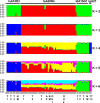Multilocus sequence typing of an emerging Cryptosporidium hominis subtype in the United States
- PMID: 24478483
- PMCID: PMC3911340
- DOI: 10.1128/JCM.02973-13
Multilocus sequence typing of an emerging Cryptosporidium hominis subtype in the United States
Abstract
The United States has experienced a substantial increase in the reported incidence of cryptosporidiosis since 2005. Accompanying this is the emergence of a new subtype of Cryptosporidium hominis based on variation at the 60-kDa glycoprotein (gp60) locus, IaA28R4, which has become a frequently identified subtype in both sporadic and outbreak-related cases. In this study, using multilocus sequence typing (MLST) at eight genetic loci, we characterized 62 specimens of IaA28R4 and 33 specimens of three other gp60 subtypes of C. hominis from four U.S. states with increased cryptosporidiosis incidences during the summer of 2008. Extensive genetic heterogeneity was seen within the gp60 subtype IaA28R4, but specimens from Ohio and southwestern states formed two distinct subpopulations, suggesting that there were at least two origins of IaA28R4 within the United States. Discordance in typing results was observed between gp60 and other genetic markers, especially DZ-HRGP, and this discordance was largely the result of genetic recombination within the gp60 subtype IaA28R4. The results of population genetic analyses supported the presence of two subpopulations of IaA28R4 and the occurrence of genetic recombination within this gp60 subtype. Thus, the IaA28R4 subtype at gp60 is likely a fitness marker for C. hominis, and genetic recombination is potentially a driving force in the emergence of the virulent IaA28R4 subtype in the United States. A rapid evolution of IaA28R4 was indicated by the observation of multiple MLST subtypes of IaA28R4 within two large outbreaks that lasted for extended periods and involved multiple swimming pools.
Figures


Similar articles
-
Population genetic characterisation of dominant Cryptosporidium parvum subtype IIaA15G2R1.Int J Parasitol. 2013 Dec;43(14):1141-7. doi: 10.1016/j.ijpara.2013.09.002. Epub 2013 Oct 12. Int J Parasitol. 2013. PMID: 24126186
-
Molecular analysis of cryptosporidiosis cases in Western Australia in 2019 and 2020 supports the occurrence of two swimming pool associated outbreaks and reveals the emergence of a rare C. hominis IbA12G3 subtype.Infect Genet Evol. 2021 Aug;92:104859. doi: 10.1016/j.meegid.2021.104859. Epub 2021 Apr 10. Infect Genet Evol. 2021. PMID: 33848684
-
Multilocus typing and population structure of Cryptosporidium from children in Zaragoza, Spain.Infect Genet Evol. 2015 Apr;31:190-7. doi: 10.1016/j.meegid.2015.01.023. Epub 2015 Feb 7. Infect Genet Evol. 2015. PMID: 25660036
-
Development of a multilocus sequence typing tool for high-resolution subtyping and genetic structure characterization of Cryptosporidium ubiquitum.Infect Genet Evol. 2016 Nov;45:256-261. doi: 10.1016/j.meegid.2016.09.011. Epub 2016 Sep 12. Infect Genet Evol. 2016. PMID: 27633152 Free PMC article.
-
Genetic richness and diversity in Cryptosporidium hominis and C. parvum reveals major knowledge gaps and a need for the application of "next generation" technologies--research review.Biotechnol Adv. 2010 Jan-Feb;28(1):17-26. doi: 10.1016/j.biotechadv.2009.08.003. Biotechnol Adv. 2010. PMID: 19699288 Review.
Cited by
-
Multilocus Sequence Typing helps understand the genetic diversity of Cryptosporidium hominis and Cryptosporidium parvum isolated from Colombian patients.PLoS One. 2022 Jul 8;17(7):e0270995. doi: 10.1371/journal.pone.0270995. eCollection 2022. PLoS One. 2022. PMID: 35802653 Free PMC article.
-
Intra-Species Diversity and Panmictic Structure of Cryptosporidium parvum Populations in Cattle Farms in Northern Spain.PLoS One. 2016 Feb 5;11(2):e0148811. doi: 10.1371/journal.pone.0148811. eCollection 2016. PLoS One. 2016. PMID: 26848837 Free PMC article.
-
Neonatal Mouse Gut Metabolites Influence Cryptosporidium parvum Infection in Intestinal Epithelial Cells.mBio. 2020 Dec 15;11(6):e02582-20. doi: 10.1128/mBio.02582-20. mBio. 2020. PMID: 33323514 Free PMC article.
-
Cryptosporidium in cattle: Assessing the zoonotic risk.Curr Res Parasitol Vector Borne Dis. 2025 Jun 14;8:100279. doi: 10.1016/j.crpvbd.2025.100279. eCollection 2025. Curr Res Parasitol Vector Borne Dis. 2025. PMID: 40656159 Free PMC article.
-
Direct Sequencing of Cryptosporidium in Stool Samples for Public Health.Front Public Health. 2019 Dec 11;7:360. doi: 10.3389/fpubh.2019.00360. eCollection 2019. Front Public Health. 2019. PMID: 31921734 Free PMC article. Review.
References
-
- Kotloff KL, Nataro JP, Blackwelder WC, Nasrin D, Farag TH, Panchalingam S, Wu Y, Sow SO, Sur D, Breiman RF, Faruque AS, Zaidi AK, Saha D, Alonso PL, Tamboura B, Sanogo D, Onwuchekwa U, Manna B, Ramamurthy T, Kanungo S, Ochieng JB, Omore R, Oundo JO, Hossain A, Das SK, Ahmed S, Qureshi S, Quadri F, Adegbola RA, Antonio M, Hossain MJ, Akinsola A, Mandomando I, Nhampossa T, Acacio S, Biswas K, O'Reilly CE, Mintz ED, Berkeley LY, Muhsen K, Sommerfelt H, Robins-Browne RM, Levine MM. 2013. Burden and aetiology of diarrhoeal disease in infants and young children in developing countries (the Global Enteric Multicenter Study, GEMS): a prospective, case-control study. Lancet 382:209–222. 10.1016/S0140-6736(13)60844-2 - DOI - PubMed
-
- Brady MT, Oleske JM, Williams PL, Elgie C, Mofenson LM, Dankner WM, Van Dyke RB, Pediatric AIDS Clinical Trials Group 219/219C Team 2010. Declines in mortality rates and changes in causes of death in HIV-1-infected children during the HAART era. J. Acquir. Immune Defic. Syndr. 53:86–94. 10.1097/QAI.0b013e3181b9869f - DOI - PMC - PubMed
-
- Yoder JS, Beach MJ. 2007. Cryptosporidiosis surveillance—United States, 2003–2005. MMWR Surveill. Summ. 56(SS-7):1–10 - PubMed
Publication types
MeSH terms
Substances
Associated data
- Actions
- Actions
- Actions
- Actions
- Actions
- Actions
- Actions
- Actions
- Actions
- Actions
- Actions
- Actions
- Actions
- Actions
- Actions
- Actions
- Actions
- Actions
- Actions
- Actions
- Actions
LinkOut - more resources
Full Text Sources
Other Literature Sources
Medical

